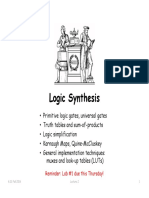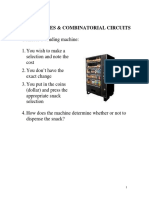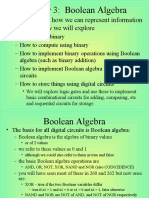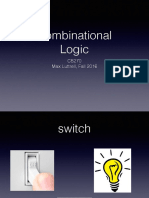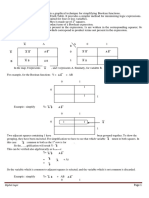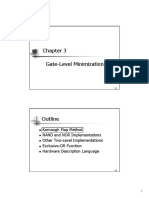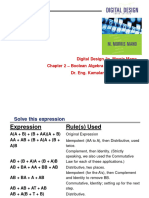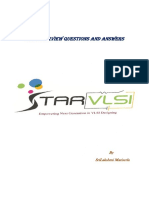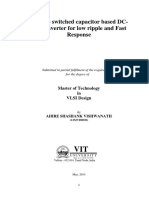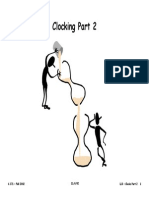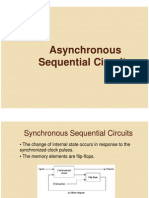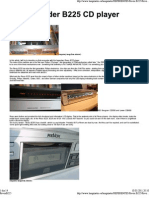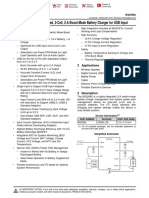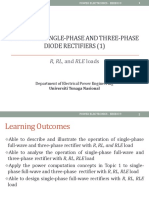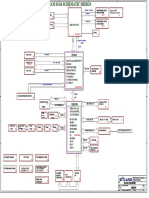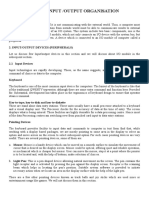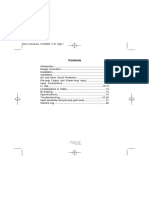Functional Specifications
input A
input B
input C
Logic Synthesis
Truth tables and sum-of-products
Primitive logic gates, universal gates
Logic simplification
Karnaugh Maps, Quine-McCluskey
General implementation techniques:
muxes and look-up tables (LUTs)
Lecture 2
I will generate a valid
output in no more than
2 minutes after
seeing valid inputs
1
!
1
-its systematic!
-it works!
-its easy!
-are we done yet???
6.111 Fall 2009
6.111 Fall 2009
Lecture 2
S-O-P Building Blocks
A Z
1. Write out our functional spec as a truth
table
2. Write down a Boolean expression with
terms covering each 1 in the output:
INVERTER:
A B
A B
=A
Bubble indicates
inversion
Y = A" B"C + A" B"C + A" B"C + A" B"C
AND:
= A" B
This approach creates equations of a
particular form called
SUM-OF-PRODUCTS
OR:
Sum (+): ORs
Products (): ANDs
Lecture 2
An concise, unambiguous technique for giving the functional
specification of a combinational device is to use a truth table to
specify the output value for each possible combination of input values
(N binary inputs -> 2N possible combinations of input values).
Heres a Design Approach
A
output Y
3 binary inputs
so 23 = 8 rows in our truth table
Reminder: Lab #1 due this Thursday!
6.111 Fall 2009
Output 1 if at
least 2 out of 3 of
my inputs are a 1.
Otherwise, output 0.
= A+ B
!
3
6.111 Fall 2009
Lecture 2
�Straightforward Synthesis
ANDs and ORs with > 2 inputs
Replace 2-input AND gates with 2-input OR
gates to create large fan-in OR gates
We can use
SUM-OF-PRODUCTS
to implement any logic
function.
= A" B"C
Only need 3 gate types:
INVERTER, AND, OR
Chain: Propagation delay increases
linearly with number of inputs
= A" B"C" D
Propagation delay:
3 levels of logic
No more than 3 gate delays assuming gates with an arbitrary
number of inputs. But, in general, well only be able to use gates
with a bounded number of inputs (bound is ~4 for most logic
families).
6.111 Fall 2009
Lecture 2
Which one should I use?
= A" B"C" D
Tree: Propagation delay increases
logarithmically with number of inputs
6.111 Fall 2009
SOP w/ 2-input gates
Lecture 2
More Building Blocks
Previous example restricted to 2-input gates:
NAND (not AND)
= A" B
A B
NOR (not OR)
= A+ B
A B
!gates are naturally inverting so we want!to use NANDs and NORs
CMOS
in CMOS designs
INV
AND2
OR2
tPD
8ps
15ps
18ps
tCD
1ps
3ps
3ps
6.111 Fall 2009
Using the timing specs given to the
left, what are tPD and tCD for this
combinational circuit?
XOR (exclusive OR)
=A"B
Hint: to find overall tPD we need to
find max tPD considering all paths
from inputs to outputs.
Lecture 2
6.111 Fall 2009
A B
XOR is very useful when implementing
parity and arithmetic logic. Also used
as a programmable inverter: if A=0,
Z=B; if A=1, Z=~B
Wide fan-in XORs can be created with
chains or trees of 2-input XORs.
Lecture 2
�SOP with NAND/NOR
Universal Building Blocks
When designing with NANDs and NORs one often makes use of
De Morgans laws:
De Morgan-ized NAND symbol
NANDs and NORs are universal:
NOR form:
A+ B = A" B
De Morgan-ized NOR symbol
of De Morgan-ized symbols to make the inversions less
!
confusing):
Lecture 2
! following SOP circuits are all equivalent (note the use
So the
Any logic function can be implemented using only NANDs
(or, equivalently, NORs). Note that chaining/treeing
technique doesnt work directly for creating wide fan-in
NAND or NOR gates. But wide fan-in gates can be created
with trees involving both NANDs, NORs and inverters.
6.111 Fall 2009
NAND form: A " B = A + B
AND/OR form
De Morgan-ized
Inverter
NAND/NAND form
NOR/NOR form
This will be handy in Lab 1 since
youll be able to use just 7400s
to implement your circuit!
All these extra inverters may seem less
than ideal but often the buffering they
provide will reduce the capacitive load on
the inputs and increase the output drive.
6.111 Fall 2009
Lecture 2
10
Boolean Minimization:
Logic Simplification
An Algebraic Approach
Can we implement the same function with fewer gates? Before
trying well add a few more tricks in our bag.
BOOLEAN ALGEBRA:
a +1=1 a + 0 = a a + a = a
OR rules:
a"
1 = a a" 0 = 0 a" a = a
AND rules:
a + b = b + a a" b = b" a
Commutative:
(a + b) + c = a + (b + c) (a " b) " c = a " (b " c)
!
Associative:
a " (b + c) = a " b + a " c a + b " c = (a + b) " (a + c)
Distributive:
!
a + a =1 a" a = 0
Complements:
!
a + a " b = a! a + a " b = a + b a " (a + b) = a a " (a + b) = a " b
Absorption:
!
De Morgans
! Law: a " b = a + b a + b = a " b
Reduction:!
a " b + a " b = b (a + b) " (a + b) = b
Lets simplify the equation from slide #3:
Y = A" B"C + A" B"C + A" B"C + A" B"C
Using the identity
!
!A + ! A = !
For any expression and variable A:
Y = A" B"C + A" B"C + A" B"C + A" B"C
!
!
Key to simplification:
equations that match the pattern of the LHS
(where b !
might be any expression) tell us that when b is true, the
value of a doesnt matter. So a can be eliminated from the equation,
getting rid of two 2-input ANDs and one 2-input OR.
6.111 Fall 2009
Lecture 2
Y = B"C + A"C + A" B
!
11
6.111 Fall 2009
The tricky part: some terms participate in more than one
reduction so cant do the algebraic steps one at a time!
Lecture 2
12
�On to Hyperspace
Karnaugh Maps: A Geometric Approach
Heres a 4-variable K-map:
K-Map: a truth table arranged so that terms which differ by exactly one
variable are adjacent to one another so we can see potential reductions
easily.
A
AB
Heres the layout of a 3-variable K-map filled in
with the values from our truth table:
00
01
11
10
1
010
000
Its cyclic. The left edge is adjacent to the right
edge. Its really just a flattened out cube.
01
11
111
101
13
01
11
10
6.111 Fall 2009
Lecture 2
Finding Subcubes
Write down a product term for the portion of each
cluster/subcube that is invariant. You only need to include
enough terms so that all the 1s are covered. Result: a minimal
sum of products expression for the truth table.
AB
00
01
11
10
CD
Three 2x1 subcubes
00
01
11
00
10
1
01
11
10
AB
00
01
11
10
Three 2x2 subcubes
Lecture 2
CD
15
Y = A"C + B"C + A" B
Were done!
AB
The best strategy is generally a greedy one.
- Circle the largest N-dimensional subcube (2N adjacent 1s)
4x4, 4x2, 4x1, 2x2, 2x1, 1x1
- Continue circling the largest remaining subcubes
(even if they overlap previous ones)
- Circle smaller and smaller subcubes until no 1s are left.
6.111 Fall 2009
14
Write Down Equations
We can identify clusters of irrelevent variables by circling
adjacent subcubes of 1s. A subcube is just a lower dimensional
cube.
AB
10
We run out of steam at 4 variables K-maps are hard to draw and
use in three dimensions (5 or 6 variables) and were not equipped
to use higher dimensions (> 6 variables)!
001
Lecture 2
00
Again its cyclic. The left edge is adjacent to the right edge,
and the top is adjacent to the bottom.
011
110
100
6.111 Fall 2009
CD
Why did he
shade that
row Gray?
AB
Z
00
00
01
11
00
01
11
10
6.111 Fall 2009
10
Z = B" D+ B"C + A"C
Lecture 2
16
�Two-Level Boolean Minimization
Prime Term Generation
Two-level Boolean minimization is used to find a sum-of-products
representation for a multiple-output Boolean function that is
optimum according to a given cost function. The typical cost
functions used are the number of product terms in a two-level
realization, the number of literals, or a combination of both. The
two steps in two-level Boolean minimization are:
Start by expressing your Boolean function using 0terms (product terms with no dont care care entries).
For compactness the table for example 4-input, 1output function F(w,x,y,z) shown to the right includes
only entries where the output of the function is 1 and
weve labeled each entry with its decimal equivalent.
Generation of the set of prime product-terms for a given function.
1-terms:
We will briefly describe the Quine-McCluskey method which was
the first algorithmic method proposed for two-level minimization
and which follows the two steps outlined above. State-of-the-art
logic minimization algorithms are all based on the Quine-McCluskey
method and also follow the two steps above.
0, 8
5, 7
7,15
8, 9
8,10
9,11
10,11
10,14
11,15
14,15
Example due to
Srini Devadas
Lecture 2
X
0
1
1
0
0
0
0
1
1
Y
0
0
1
0
0
1
1
1
1
Z
0
1
1
0
1
0
1
0
1
label
0
5
7
8
9
10
11
14
15
Look for pairs of 0-terms that differ in only one bit position and merge
them in a 1-term (i.e., a term that has exactly one entry). Next 1-terms
are examined in pairs to see if the can be merged into 2-terms, etc. Mark
k-terms that get merged into (k+1) terms so we can discard them later.
Selection of a minimum set of prime terms to implement the
function.
6.111 Fall 2009
W
0
0
0
1
1
1
1
1
1
17
6.111 Fall 2009
2-terms:
-000 [A]
01-1 [B]
-111 [C]
10010-0
10-1
1011-10
1-11
111-
8, 9,10,11
10,11,14,15
3-terms:
10-- [D]
1-1- [E]
none!
Label unmerged terms:
these terms are prime!
Lecture 2
18
Prime Term Table
Dominated Columns
An X in the prime term table in row R and column C signifies that the 0term corresponding to row R is contained by the prime corresponding to
column C.
Some functions may not have essential primes (Fig. 1), so make arbitrary
selection of first prime in cover, say A (Fig. 2). A column U of a prime
term table dominates V if U contains every row contained in V. Delete the
dominated columns (Fig. 3).
Goal: select the minimum
set of primes (columns)
such that there is at least
one X in every row. This
is the classical minimum
covering problem.
0000
0101
0111
1000
1001
1010
1011
1110
1111
A
X
.
.
X
.
.
.
.
.
B
.
X
X
.
.
.
.
.
.
C
.
.
X
.
.
.
.
.
X
D
.
.
.
X
X
X
X
.
.
E
.
.
.
.
.
X
X
X
X
1. Prime table
A is essential
B is essential
0000
0001
0101
0111
1000
1010
1110
1111
D is essential
E is essential
Each row with a single X signifies an essential prime term since any prime
implementation will have to include that prime term because the
corresponding 0-term is not contained in any other prime.
Lecture 2
B
.
X
X
.
.
.
.
.
C
.
.
X
X
.
.
.
.
D
.
.
.
X
.
.
.
X
E
.
.
.
.
.
.
X
X
F
.
.
.
.
.
X
X
.
G
.
.
.
.
X
X
.
.
H
X
.
.
.
X
.
.
.
0101
0111
1000
1010
1110
1111
B
X
.
.
.
.
.
C
X
X
.
.
.
.
D
.
X
.
.
.
X
E
.
.
.
.
X
X
F
.
.
.
X
X
.
G
.
.
X
X
.
.
H
.
.
X
.
.
.
C dominates B,
G dominates H
3. Table with B & H removed
0101
0111
1000
1010
1110
1111
C
X
X
.
.
.
.
D
.
X
.
.
.
X
E
.
.
.
.
X
X
F
.
.
.
X
X
.
G
.
.
X
X
.
.
C is essential
G is essential
Selecting C and G
shows that only E is
needed to complete
the cover
This gives a prime cover of {A, C, E, G}. Now backtrack to our choice of
A and explore a different (arbitrary) first choice; repeat, remembering
minimum cover found during search.
In this example the essential primes cover all the 0-terms.
6.111 Fall 2009
A
X
X
.
.
.
.
.
.
2. Table with A selected
19
6.111 Fall 2009
Lecture 2
20
�The Quine-McCluskey Method
Logic that defies SOP simplification
The input to the procedure is the prime term table T.
1. Delete the dominated primes (columns) in T. Detect essential primes in T by checking to see if
any 0-term is contained by a single prime. Add these essential primes to the selected set. Repeat
until no new essential primes are detected.
Ci
0
0
0
0
1
1
1
1
2. If the size of the selected set of primes equals or exceeds the best solution thus far return
from this level of recursion. If there are no elements left to be contained, declare the selected
set as the best solution recorded thus far.
3. Heuristically select a prime.
4. Add the chosen prime to the selected set and create a new table by deleting the prime and all
0-terms that are contained by this prime in the original table. Set T to this new table and go to
Step 1.
!
!
21
6.111 Fall 2009
B
C
If C is 1 then
copy B to Y,
otherwise copy
A to Y
2-input Multiplexer
B
C
Co
FA
Ci
0
0
11S
I2
0
0
I3 1
1S
00
01
11
10
C/AB
00
01
11
10
22
... using a MULTIPLEXER
as the only circuit element:
A 4-input Mux
implemented as
a tree
I0 0
0
I1 11
S
C/AB
CO
Consider implementation of some
arbitrary Boolean function, F(A,B)
S0
S1
Gate
symbol
Lecture 2
A B
Systematic Implementation of
Combinational Logic
C
schematic
6.111 Fall 2009
Full Adder
Lecture 2
Truth Table
Y
Co
0
0
0
1
0
1
1
1
The sum S doesnt have a simple sum-of-products implementation
even though it can be implemented using only two 2-input XOR
gates.
Logic Synthesis Using MUXes
A
S
0
1
1
0
1
0
0
1
CO = A " C + B " C + A " B
The good news: this technique generalizes to multi-output functions. The
bad news: the search time grows as 2^(2^N) where N is the number of
inputs. So most modern minimization systems use heuristics to make
dramatic reductions in the processing time.
Lecture 2
B
0
1
0
1
0
1
0
1
S = A" B"C + A" B"C + A" B"C + A" B"C = A # B # C
Then, create a new table by deleting the chosen prime from the original table without adding it to
the selected set. No 0-terms are deleted from the original table. Set T to this new table and go
to Step 1.
6.111 Fall 2009
A
0
0
1
1
0
0
1
1
23
6.111 Fall 2009
Full-Adder
Carry Out Logic
0
0
0
1
1
0
1
1
0
1
2
3
4
5
6
7
Cout
A,B,Cin
Lecture 2
24
�Xilinx Virtex II FPGA
Systematic Implementation of
Combinational Logic
Same function as on previous slide, but this
time lets use a 4-input mux
6.111 Fall 2009
Full-Adder
Carry Out Logic
0
Cin
Cin
1
0
1
2
3
Cout
XC2V6000:
957 pins, 684 IOBs
CLB array: 88 cols x 96/col = 8448 CLBs
18Kbit BRAMs = 6 cols x 24/col = 144 BRAMs = 2.5Mbits
18x18 multipliers = 6 cols x 24/col = 144 multipliers
A,B
Lecture 2
25
6.111 Fall 2009
Virtex II CLB
Lecture 2
Lecture 2
26
Virtex II Slice Schematic
Control signals whose values
are set at configuration time.
The Xilinx tools compile your
design and determine the
settings
16 bits of RAM which can be configured as a 16x1
single- or dual-port RAM, a 16-bit shift register,
or a 16-location lookup table
Figures from Xilinx Virtex II datasheet
6.111 Fall 2009
Figures from Xilinx Virtex II datasheet
Figures from Xilinx Virtex II datasheet
27
6.111 Fall 2009
Lecture 2
28
�Virtex II Sum-of-products
Wide fan-in OR
Wide fan-in AND
Figures from Xilinx Virtex II datasheet
6.111 Fall 2009
Lecture 2
29
